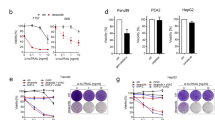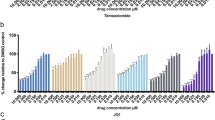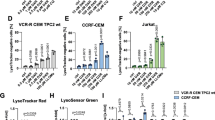Abstract
Resistance of tumors to cytotoxic therapy may be due to disrupted apoptosis programs and remains a major obstacle in cancer treatment. Here, we report that IFNγ sensitizes resistant tumor cells with absent or low caspase-8 expression for apoptosis induced by death-inducing ligands or cytotoxic drugs by upregulating caspase-8 through a Stat1/IRF1 dependent pathway. Combined treatment using IFNγ with TRAIL, APO1, TNFα or cytotoxic drugs cooperated to trigger apoptosis in various resistant tumor cell lines derived from Ewing tumor, neuroblastoma or medulloblastoma, while single agents exerted only a minimal effect. Importantly, IFNγ induced caspase-8 expression also in cells with inactivation of the caspase-8 gene by hypermethylation, although no direct effect of IFNγ on the methylation status of regulatory sequences of the caspase-8 gene was found. IFNγ-mediated facilitation of apoptosis was inhibited by the caspase-8 specific inhibitor zIETD.fmk or in caspase-8 mutant Jurkat cells implying a prominent role of caspase-8 in mediating sensitization by IFNγ. Upregulation of caspase-8 and sensitization for apoptosis by IFNγ was blocked by overexpression of dominant-negative mutants of Stat1 or in Stat1-deficient U3A cells, while complementation of Stat1-deficient U3A cells with wild-type Stat1 restored the IFNγ effect. Moreover, ectopic expression of IRF1 induced caspase-8 expression thereby sensitizing cells for TRAIL-, APO1- or doxorubicin-induced apoptosis. These findings provide evidence that the Stat1/IRF1 pathway is involved in induction of caspase-8 expression and apoptosis initiated by IFNγ and indicate that IFNγ might be an effective strategy to sensitize various resistant tumor cells with deficient caspase-8 expression for chemotherapy- or death receptor-induced apoptosis.
This is a preview of subscription content, access via your institution
Access options
Subscribe to this journal
Receive 50 print issues and online access
$259.00 per year
only $5.18 per issue
Buy this article
- Purchase on Springer Link
- Instant access to full article PDF
Prices may be subject to local taxes which are calculated during checkout







Similar content being viewed by others
References
Boehm U, Klamp T, Groot M, Howard JC . 1997 Ann. Rev. Immunol. 15: 749–795
Bromberg J, Darnell Jr JE . 2000 Oncogene 19: 2468–2473
Darnell Jr JE, Kerr IM, Stark GR . 1994 Science 264: 1415–1421
Debatin KM . 1997 J. Natl. Cancer Inst. 89: 750–751
Deveraux QL, Reed JC . 1999 Genes Dev. 13: 239–252
Friesen C, Herr I, Krammer PH, Debatin KM . 1996 Nat. Med. 2: 574–577
Friesen C, Fulda S, Debatin KM . 1997 Leukemia 11: 1833–1841
Fulda S, Sieverts H, Friesen C, Herr I, Debatin KM . 1997 Cancer Res. 57: 3823–3829
Fulda S, Susin SA, Kroemer G, Debatin KM . 1998 Cancer Res. 58: 4453–4460
Fulda S, Meyer E, Debatin KM . 2000 Cancer Res. 60: 3947–3956
Fulda S, Küfer M, van Valen F, Dockhorn-Dworniczak B, Debatin KM . 2001 Oncogene 20: 5865–5877
Grenet J, Teitz T, Wei T, Valentine V, Kidd VJ . 1999 Gene 226: 225–232
Griffith TS, Lynch DH . 1998 Curr. Opin. Immunol. 10: 559–563
Hendrich B, Bird A . 2000 Curr. Top. Microbiol. Immunol. 249: 55–74
Herman JG, Graff JR, Myohanen S, Nelkin BD, Baylin SB . 1996 Proc. Natl. Acad. Sci. USA 93: 9821–9826
Herman JG, Baylin SB . 2000 Curr. Top. Microbiol. Immunol. 249: 35–54
Iwase S, Furukawa Y, Kikuchi J, Saito S, Nakamura M, Nakayama R, Horiguchi-Yamada J, Yamada H . 1999 FEBS Lett. 450: 263–267
Jones PA . 1985 Cell 40: 485–486
Juo P, Kuo CJ, Yuan J, Blenis J . 1998 Curr. Biol. 8: 1001–1008
Kaufmann SH, Earnshaw WC . 2000 Exp. Cell Res. 256: 42–49
Kroemer G . 1997 Nat. Med. 3: 614–620
Kroemer G, Reed JC . 2000 Nat. Med. 6: 513–519
Los M, Wesselborg S, Schulze-Osthoff K . 1999 Immunity 10: 629–639
Lutz W, Fulda S, Jeremias I, Debatin KM, Schwab M . 1998 Oncogene 17: 339–346
Maris JM, Matthay KK . 1999 J. Clin. Onco. 17: 2264–2279
McKendry R, John J, Flavell D, Muller M, Kerr IM, Stark GR . 1991 Proc. Natl. Acad. Sci. USA 88: 11455–11459
Montaldo PG, Carbone R, Corrias MV, Ferraris PC, Ponzoni M . 1994 J. Natl. Cancer Inst. 86: 1694–1701
Nicholson DW . 1999 Cell Death Differ. 6: 1028–1042
Ossina NK, Cannas A, Powers VC, Fitzpatrick PA, Knight JD, Gilbert JR, Shekhtman EM, Tomei LD, Umansky SR, Kiefer MC . 1997 J. Biol. Chem. 272: 16351–16357
Peter ME, Krammer PH . 1998 Curr. Opin. Immunol. 10: 545–551
Rountree MR, Bachman KE, Herman JG, Baylin SB . 2001 Oncogene 20: 3156–3165
Ruiz-Ruiz C, Munoz-Pinedo C, Lopez-Rivas A . 2000 Cancer Res. 60: 5673–5680
Salvesen GS, Dixit VM . 1999 Proc. Natl. Acad. Sci. USA 6: 10964–10967
Scaffidi C, Medema JP, Krammer PH, Peter ME . 1997 J. Biol. Chem. 272: 26953–26958
Sprick MR, Weigand MA, Rieser E, Rauch CT, Juo P, Blenis J, Krammer PH, Walczak H . 2000 Immunity 12: 599–609
Stark GR, Kerr IM, Williams BR, Silverman RH, Schreiber RD . 1998 Ann. Rev. Biochem. 67: 227–264
Susin SA, Lorenzo HK, Zamzami N, Marzo I, Snow BE, Brothers GM, Mangion J, Jacotot E, Costantini P, Loeffler M, Larochette N, Goodlett DR, Aebersold R, Siderovski DP, Penninger JM, Kroemer G . 1999 Nature 397: 441–446
Tang D, Lahti JM, Kidd VJ . 2000 J. Biol. Chem. 275: 9303–9307
Taniguchi T, Lamphier MS, Tanaka N . 1997 Biochim. Biophys. Acta 1333: M9–M17
Teitz T, Wei T, Valentine MB, Vanin EF, Grenet J, Valentine VA, Behm FG, Look AT, Lahti JM, Kidd VJ . 2000 Nat. Med. 6: 529–535
Thornberry N, Lazebnik Y . 1998 Science 281: 1312–1316
Tschopp J, Irmler M, Thome M . 1998 Curr. Opin. Immunol. 10: 552–558
Van Valen F . 1999 Ewing's Sarcoma Family of Tumors Masters JRW and Palsson B (eds) Great Britain: Kluwer Academic Publishers pp 55–85
Wadler S, Schwartz EL . 1990 Cancer Res. 50: 3473–3486
Acknowledgements
We thank Petra Miller-Rostek for expert technical assistance, PH Krammer (DKFZ, Heidelberg, Germany) for anti-FLICE antibody, JF Bromberg (The Rockefeller University, New York, USA) for pRcCMV plasmid containing Stat1 Y701F or Stat1β cDNA, S Iwase (Aoto Hospital, Tokyo, Japan) for pCR3.1 plasmid containing IRF1 cDNA, GR Stark (The Cleveland Clinic Foundation, Cleveland, USA) for 2fTGH, U3A and U3AStat1 cells and J Blenis (Harvard Medical School, Boston, USA) for caspase-8 mutant Jurkat cells. This work has been partially supported by grants from the Deutsche Forschungsgemeinschaft, the Bundesministerium für Forschung and Technologie, Bonn, the Deutsche Leukämieforschungshilfe and the Wilhelm Sander-Stiftung.
Author information
Authors and Affiliations
Corresponding author
Rights and permissions
About this article
Cite this article
Fulda, S., Debatin, KM. IFNγ sensitizes for apoptosis by upregulating caspase-8 expression through the Stat1 pathway. Oncogene 21, 2295–2308 (2002). https://doi.org/10.1038/sj.onc.1205255
Received:
Revised:
Accepted:
Published:
Issue Date:
DOI: https://doi.org/10.1038/sj.onc.1205255
Keywords
This article is cited by
-
Harnessing TRAIL-induced cell death for cancer therapy: a long walk with thrilling discoveries
Cell Death & Differentiation (2023)
-
An inhibitory effect on the nuclear accumulation of phospho-STAT1 by its unphosphorylated form
Cell Communication and Signaling (2022)
-
STAT1 is regulated by TRIM24 and promotes immunosuppression in head and neck squamous carcinoma cells, but enhances T cell antitumour immunity in the tumour microenvironment
British Journal of Cancer (2022)
-
Ubiquitin ligase STUB1 destabilizes IFNγ-receptor complex to suppress tumor IFNγ signaling
Nature Communications (2022)
-
Bempegaldesleukin selectively depletes intratumoral Tregs and potentiates T cell-mediated cancer therapy
Nature Communications (2020)



